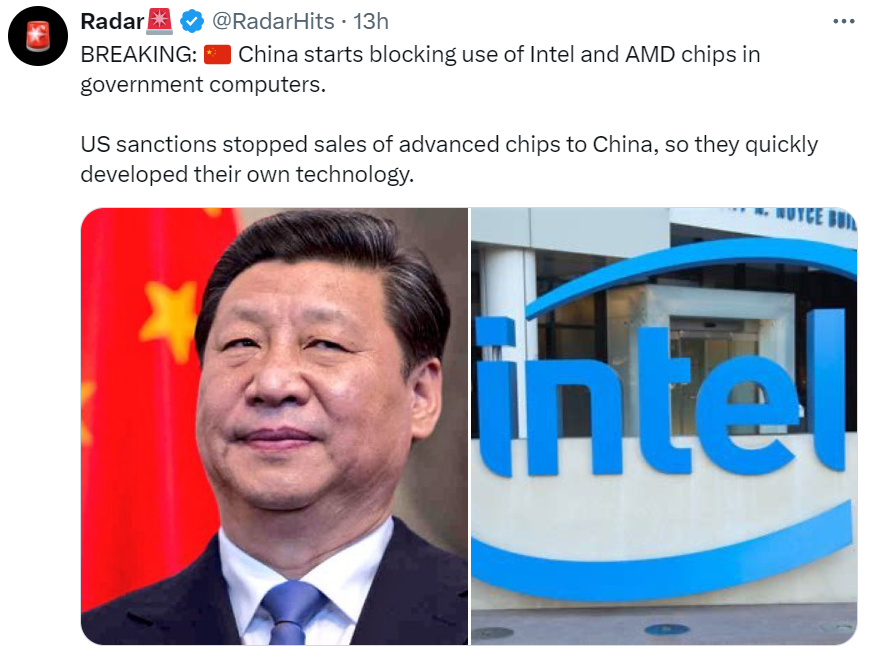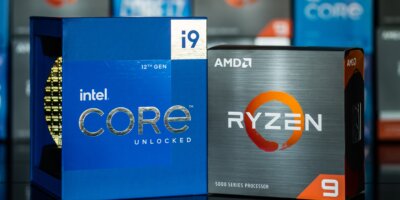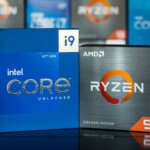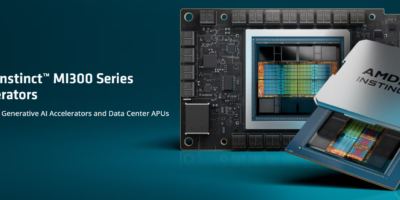
Intel and AMD navigate China’s push for domestic technology (Source – Shutterstock)
China’s new tech policies challenge Intel and AMD in a shifting landscape
- China’s push for tech self-reliance shakes up the semiconductor industry, impacting giants like Intel and AMD.
- Intel’s ambitious U.S. expansion and AMD’s strategic product launches in China highlight the evolving strategies of semiconductor leaders amid global tech tensions.
The ongoing tension between China and the United States has escalated, with China implementing guidelines to phase out U.S. microprocessors in government computers and servers, including those from Intel and AMD. This initiative is part of Beijing’s broader strategy to replace foreign technology with domestic alternatives.
The Financial Times reports that this directive goes beyond hardware, targeting the replacement of Microsoft’s Windows operating system and foreign database software with local versions. This move is a reflection of China’s nationwide drive towards technological self-reliance, known as “xinchuang,” or IT application innovation.
China’s domestic focus and U.S. countermeasures
Amid increasing tensions, China’s latest procurement rules represent a substantial effort to cultivate domestic technological alternatives. These developments mirror actions in the U.S., where sanctions on Chinese companies for security reasons, legislation to enhance domestic tech production, and restrictions on advanced chip exports to China have intensified.
The rules, discreetly announced last December and effective this year, require government agencies and party organizations to prioritize “safe and reliable” technology for their IT purchases, focusing on domestically produced processors and operating systems.
On the day the guidelines were introduced, China’s Information Technology Security Evaluation Center listed approved “safe and reliable” technologies, exclusively from Chinese sources, including processors from companies like Huawei and Phytium, which Washington blacklists. These processors utilize a mix of chip architectures, and the operating systems are derived from open-source Linux.
The shift towards domestic technology extends beyond the government sector. State-owned enterprises have been instructed to transition to local providers by 2027, which poses significant financial implications for U.S. tech giants like Intel, AMD, and Microsoft, all of which have substantial sales in China. The approval of their products in the future will require the sharing of detailed R&D documentation and evidence of significant local development.

China has started to block Intel and AMD chips in government computers (Source – X)
Local and provincial finance ministries are ensuring widespread compliance with the new guidelines, although some leeway remains for acquiring foreign technology. Nonetheless, the clear trend towards domestic technology is evident, with officials noting the necessity of additional justification for the purchase of foreign processors.
This inclination towards homegrown technology is anticipated to accelerate, particularly for server processors, due to the simpler transition of the software ecosystem, emphasizing China’s commitment to technological independence and the potential for a significant shift in global tech supply and demand dynamics.
What’s next for Intel and AMD?
The recent challenges faced by Intel and AMD, especially China’s initiative to eliminate U.S. microprocessors in favor of domestic options, emerge at a crucial time for both companies. For Intel, this unfolds as it embarks on an ambitious expansion in the United States, planning to create “the largest AI chip manufacturing site in the world” with a US$100 billion investment over five years.
Quartz has reported that Intel’s CEO, Pat Gelsinger, aims to establish a significant manufacturing site near Columbus, Ohio. This effort is part of a larger investment across four states, with potential construction starting as early as 2027. Supported by nearly $20 billion in federal funding and loans from the Biden administration’s CHIPS and Science Act, this initiative is designed to reinforce American semiconductor leadership.
The CHIPS and Science Act has allocated up to US$8.5 billion in direct funding for Intel, with eligibility for an additional US$11 billion in loans, to boost its semiconductor manufacturing presence in Arizona, New Mexico, Ohio, and Oregon.
During a recent event featuring President Joe Biden at Intel’s Arizona campus, Gelsinger underscored these investments’ national economic and security benefits. He highlighted the critical role of semiconductors in the digital transformation of society and argued that chip production is fundamental to the future of humanity.
Gelsinger also addressed the competitive dimension of these initiatives, emphasizing the importance of maintaining leadership in the semiconductor field, particularly in light of the U.S.-China chip rivalry and the rapid advancements in AI technology.
Despite the U.S.’s former dominance in semiconductor development, it now produces less than 10% of the world’s chips and is not involved in manufacturing the most advanced semiconductors.
Intel’s strategic investments are expected to generate approximately 80,000 jobs, including direct positions within the company, construction jobs, and indirect roles in supplier and related industries. Furthermore, Intel intends to take advantage of a tax credit from the U.S. Treasury Department, worth up to 25% on over US$100 billion in qualified investments.
This contrast between Intel’s aggressive U.S. expansion and the challenges posed by China’s new procurement policies outlines a complex scenario. For Intel, and by extension AMD, China’s move towards domestic technology could signify a considerable market loss.
However, Intel’s substantial investment in U.S. manufacturing and government support represents a strategic shift towards bolstering domestic semiconductor production. This is not merely an economic strategy but a measure of national security and technological sovereignty amidst global competition.
AMD’s innovative response in China
So, that’s what’s going on with Intel. However, AMD was also in the spotlight, as it was recently in China. AMD’s recent appearance in China, marked by the Ryzen AI PC Innovation Summit in Beijing, showcased the launch of the Ryzen 8040 series and 8000G desktop solutions tailored for the Chinese market.
The practice of AMD and Intel marking processors without onboard graphics with an “F” suffix, likely due to iGPU performance issues during manufacturing, presents a unique strategy. Instead of discarding these units, they are repurposed and sold at a lower price, appealing to PC enthusiasts who prioritize discrete graphics cards over integrated GPUs.
Tom’s Hardware highlights that the Ryzen 7 8700F and Ryzen 5 8400F underscore AMD’s competitive strategy across various price points. This strategy ensures a comprehensive range of products, extending from the affordable Athlon 3000G to the Ryzen 5000 series, and now includes the Ryzen 8000 desktop APUs (without graphics), further expanding the options available to AM5 motherboard owners.
Although specifics for the Ryzen 7 8700F and Ryzen 5 8400F remain unknown (for now), it’s reasonable to infer they share similarities with the AMD Ryzen 8000G Series 65W Phoenix APUs, albeit without the iGPU. For instance, the Ryzen 7 8700G, with its 8-core/16-thread configuration based on the Zen 4 architecture, boasts boost speeds up to 5.1 GHz and a 65W TDP, alongside a powerful Radeon 780M GPU. The CPU specs for the F series are likely identical, with the notable absence of onboard graphics.
The lack of a Ryzen 5 8400G makes speculating about the Ryzen 5 8400F’s specifications challenging. However, it’s plausible that this new Ryzen 5 variant will feature a 6-core/12-thread (or possibly 6-core/6-thread) CPU configuration, adhering to the Zen 4 architecture but without integrated graphics.
It’s important to note that the Ryzen 7 8700F and Ryzen 5 8400F may be exclusive to the Chinese market, thereby circumventing speculation regarding their pricing relative to the G-suffixed counterparts. Although speculation from HXL suggests these products are intended solely for China, AMD’s region-specific offerings have historically found their way to international markets, as evidenced by the Radeon ‘Golden Rabbit Edition’ GPUs now available in Western retail settings.
This strategic maneuver by AMD, amidst Intel’s substantial investment in expanding U.S. semiconductor manufacturing, reflects the broader dynamics of global technology competition and adaptation. As both companies navigate the complexities of international markets and political tensions, their initiatives in China and the United States underline the intricate balance between local adaptation and global strategic positioning.
As China forges ahead with its plans for tech independence, the ripple effects are felt deeply by semiconductor heavyweights such as Intel and AMD. The unfolding scenario underscores a pivotal moment in the semiconductor sector, spotlighting the intricate dance between national ambitions and the interconnectedness of global technology ecosystems.
READ MORE
- Safer Automation: How Sophic and Firmus Succeeded in Malaysia with MDEC’s Support
- Privilege granted, not gained: Intelligent authorization for enhanced infrastructure productivity
- Low-Code produces the Proof-of-Possibilities
- New Wearables Enable Staff to Work Faster and Safer
- Experts weigh in on Oracle’s departure from adland




